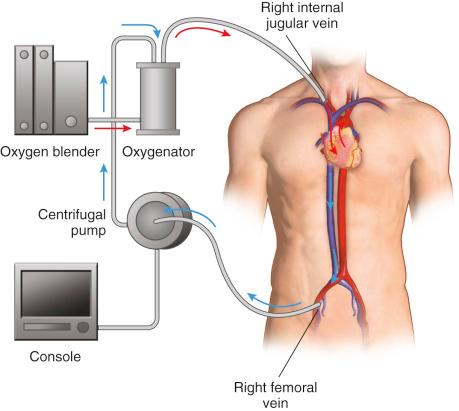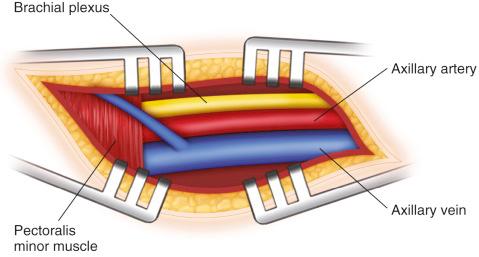Physical Address
304 North Cardinal St.
Dorchester Center, MA 02124
Extracorporeal membrane oxygenation (ECMO) pertains to prolonged extracorporeal cardiopulmonary bypass using intrathoracic or extrathoracic vascular cannulation. The bypass circuit includes a distensible venous blood reservoir receiving deoxygenated blood from the patient passing through a nonocclusive centrifugal pump toward the membrane oxygenator and countercurrent heat exchanger to be delivered finally to the patient via an arterial or venous cannula ( Fig. 31.1 ). To prevent thrombosis within the ECMO circuit from blood tubing contact interactions, patients are generally anticoagulated with heparin or bivalrudin.

Providing full or partial circulatory support with adequate gas exchange is the primary objective of ECMO. Broad indications for initiating ECMO include isolated cardiac failure, respiratory failure, and cardiorespiratory failure. The arrangement of the cannulae and ECMO circuit can be varied, depending on the indication for extracorporeal life support. Generally, patients with isolated respiratory failure can be supported with venovenous ECMO, whereas patients with cardiac or cardiorespiratory failure will require venoarterial ECMO.
ECMO was first used in the early 1970s and, although several studies have demonstrated poor clinical outcomes, successes were individually dramatic. In an effort to evaluate, improve, and innovate ECMO therapy, the Extracorporeal Life Support Organization (ELSO) was established in 1989. This international multicenter registry reports clinical outcomes in adult and children who are undergoing various forms of ECMO therapy.
The key for successful ECMO cannula placement is understanding the anatomy of the common femoral artery, with emphasis on its branches and its relationship to the inguinal ligament and common femoral vein ( Fig. 31.2 ). When performing a surgical cutdown for ECMO placement, it is critical to identify and dissect out the superficial femoral and profunda femoris arteries to ensure cannulation of the common femoral artery proper and to consider placement of an antegrade perfusion catheter in the superficial femoral artery.

To provide safe control of the proximal aspect of the common femoral artery, part of the inguinal ligament may need to be divided.
Cardiac surgeons should also be familiar with the pertinent anatomy of the axillary and subclavian arteries. In particular, the axillary vein is anterosuperior to the artery, and the brachial plexus is posterolateral ( Fig. 31.3 ).

It is imperative to determine whether a patient requiring ECMO has a potentially reversible underlying pathologic process or has plans for longer term therapy (e.g., left ventricular assist device, heart or lung transplantation). General indications include acute reversible respiratory or cardiac failure unresponsive to optimal medical therapy for which recovery can be expected within a sensible time frame. Contraindications include patients with active bleeding, conditions incompatible with a normal quality of life after cardiac or lung recovery (e.g., major brain injury) and mechanical ventilation for more than 10 days.
After deciding which type of ECMO circuit would provide maximal oxygenation and/or circulatory support, the surgeon will need to devise a cannulation strategy. This can be divided into central (thoracic) or peripheral (extrathoracic) cannulation. Venovenous ECMO in the setting of respiratory failure will typically be performed via peripheral cannulation—the femoral and/or jugular vein). Although most venoarterial ECMO procedures are performed via peripheral cannulation, a central cannulation strategy (i.e., right atrium and ascending aorta) may be considered in the setting of post–cardiopulmonary bypass patients or for those who require effective left ventricular venting. Finally, appropriately sized arterial and venous cannulae must be chosen to provide adequate flow.
Percutaneous peripheral ECMO cannulation can now be performed in both the venovenous and venoarterial ECMO settings. A single double-lumen cannula for venovenous ECMO can be placed under guidance by transesophageal echocardiography (TEE) and/or fluoroscopy.
After establishing full cardiorespiratory support, the team must routinely assess for distal limb perfusion in the setting of peripheral arterial cannulation, the need for left ventricular venting and, finally, preventing upper body hypoxia. The latter situation can occur when a venoarterial ECMO patient ejects deoxygenated blood from the left ventricle and the oxygenated femoral arterial cannula flow is prevented from reaching the upper body. In this setting, an additional peripheral venous cannula can be placed to provide oxygenated blood from the ECMO circuit.
Become a Clinical Tree membership for Full access and enjoy Unlimited articles
If you are a member. Log in here